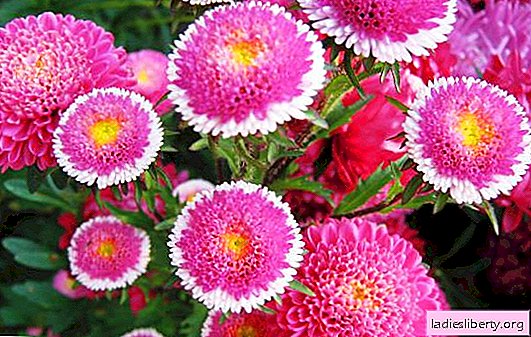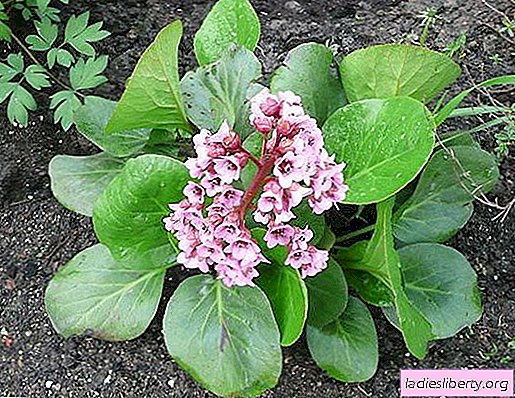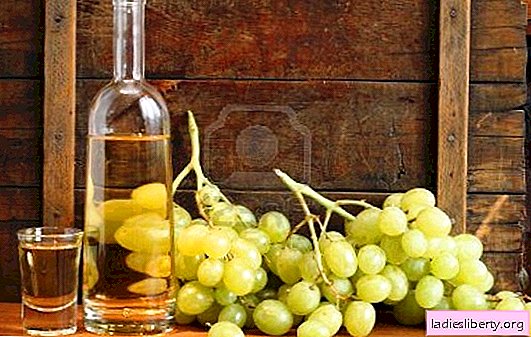
One-year asters decorate autumn gardens with bright colors. Their petals are painted with a variety of colors: white, blue, pink, red, yellow.
There are varieties with double-colored flowers. The shape and size of inflorescences depends on the variety.
There are asters with chamomile, peony and double flowers, which form various bushes from dwarf to tall.
Almost all gardeners can observe the beautiful flowering of this annual, because the aster belongs to unpretentious plants. But some secrets on growing and caring for the flower need to know.
Growing asters in the garden (photo)
Any amateur gardener can engage in breeding asters. Annuals are well propagated by seeds, from which many varieties of asters can be grown.
Before proceeding to planting seeds for seedlings, it is necessary to determine the purpose of the plant. All further care and landing depends on it.
Conventionally, annual asters can be divided into several groups:
• By the timing of flowering. There are early, medium and late flowering plants.
• The height of the bush. Breeders have deduced several forms of an annual plant: dwarf (up to 25 cm in height), stunted (up to 40 cm), medium-sized (up to 50-60 cm), tall (up to 80 cm), giant (over 80 cm).
• For targeted cultivation. Asters are cutting, as a rule, these are tall varieties with large flowers, casing - compact bushes, used in flower beds and as a pot plant, universal - medium-sized bushes with large beautiful flowers, suitable for cutting and as a flower garden decoration.
• The shape and structure of inflorescences. Simple tubular inflorescences, transitional - the flower has tubular and reed petals, reed - they are divided into non-double, coronal, semi-double, curly, spherical, needle, hemispherical inflorescences.

This division is not universal, since every year there are many new varieties that create other groups or complement existing ones.
How to grow asters from seeds
To breed this annual is very simple. Astra is propagated by seeds, which can be sown in two ways:
• seedlings;
• sowing in soil.
Growing seedlings of an annual aster takes time, but this is the most reliable way to plant a plant. Sowing of seeds begins in April-May, depending on the variety. Before planting, the seeds are disinfected in a potassium permanganate solution. They are wrapped in cotton cloth and soaked in a weak solution overnight. Next, the seeds are placed in a bag and cleaned in a warm place for germination. Astra seedlings are grown in any containers suitable in volume.

Annuals prefer nutritious and light soil. Garden soil is suitable, but peat and sand are added to it. The substrate for sowing seeds must be decontaminated. To do this, it is watered with a solution of potassium permanganate.
Prepared soil is filled in containers for seedlings. The soil is slightly compacted and grooves are made for sowing seeds. Germinated seeds are laid out in grooves and sprinkled with a layer of sand. Landings are covered with glass and cleaned in a warm place with a temperature of about 25 degrees.
Fresh seeds emerge in a few days. As soon as the shoots appear, the containers are transferred to a cooler room, where the temperature is regulated at 16 degrees. Further, seedlings must be well looked after, moderately watered.
As soon as the asters grow up and release up to 4 real leaves, they are dived into separate containers. In this case, the root system of the plant needs to be pinched. For a dive, a soil mixture of the same composition is used, but ash is added to it. When caring for seedlings, excessive irrigation should be avoided, since plants can become ill with a black leg.

Many gardeners sow aster seeds directly into the open ground. At the same time, early varieties begin to sow in early April, and later ones in early May. Sowing technology is no different from growing seedlings. Seeds are sown in grooves and dive into the flower garden.
Important! Plants grown in this way bloom later than others.
By choosing the varieties and sowing dates correctly, you can enjoy flowering asters from early August to late September, in some areas until the frosts.
Sowing astra seeds in open ground can be done not only in spring, but also in autumn, immediately after harvesting. Sowing is carried out on frozen ground, when spring seedlings appear, they are thinned out. Asters grown in this way are less sick and are attacked by pests.
Important! Seed germination persists for two years, then it decreases by half.
How to plant asters: the choice of place and method of planting
Before planting seedlings in the flower garden, it is prepared for the conditions in which it will be grown.
A week after picking plants in separate containers, they are fed complex fertilizers. In the future, fertilizers are applied once a week until the landing. Seedlings are tempered, taken out to fresh air.
Where to plant asters?
A flower bed with asters is best to be planted in a sunny area with well-drained soil, which is prepared in advance. During the autumn digging, humus and compost are introduced.
Before planting, weed away the selected place, remove weeds and loosen it to a depth of 8 cm. Planting asters is carried out in shallow grooves, which are pre-watered, adhering to the distance between the seedlings of about 20 cm. You can retreat more or less, it all depends on the variety that will be grown . Between grooves leave up to 50 cm. Planted seedlings are watered and mulched. After a week, asters can be fed nitrogen-containing fertilizers.
Aster Care
Any gardener will answer the question about caring for asters. After all, this is an unpretentious plant that does not require much effort. However, there are some rules that you must adhere to.
1. Regular loosening of the soil. After rain or watering, the soil around the plants must be loosened, combining this with weeding weeds. Before the branching of the bush, the lower part of the stem is spudded, which accelerates the growth of roots.
2. Timely watering. Astra does not tolerate dry soil, but she will not like the waterlogging of the roots. Watering is carried out as the soil dries. Untimely watering leads to the fact that the flower loses its decorativeness.
3. Feeding. Caring for asters, we must not forget about top dressing. During the season, it is useful to fertilize the plant at least three times.
4. Removing faded inflorescences. Dry flowers need to be cut regularly, otherwise the plant loses its decorativeness, and the flowering time is reduced.
What are the difficulties in growing an annual aster (photo)
Even unpretentious asters can make an inexperienced gardener nervous who first decided to decorate the garden with their beautiful inflorescences.
• The first difficulties arise after sowing. Seeds do not germinate or seedlings disappear. The reason lies in the insufficient pre-sowing cultivation of soil or seeds. You can sow the seeds, observing all agricultural practices.
• Asters fell ill with Fusarium. The reason is the wrong fertilizer and the choice of a place for landing. Asters do not plant after tulips, left-handed, gladioli. Also, you can not make fresh manure under the plants.

• Inflorescences are incomplete, ugly and twisted. The reason is that pests have settled on the asters or are not fed enough. Of the possible pests, asters are affected by aphids and spider mites. With a lack of nutrition, you need to feed the plants.
Observing all agricultural techniques, growing asters will not take all the time and effort, but it will delight you with bright colors on the eve of the outgoing summer.











